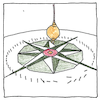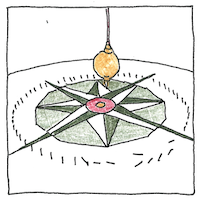Léon Foucault
geodesy

|
Foucault’s pendulum
A moving object is not bound to our frame of reference but has an independent bearing. We whirl about on Earth apparently at rest, unaware of a slight centrifugal effect, while the stars rotate about us. Parallel lines on every surface we see dip, waver, and vanish toward a point capable of deceiving the eye, which we ignore to imagine a flatness impossible in our curved universe. Léon Foucault hung his pendulum from the dome of the Pantheon in Paris and noted that it rotated clockwise eleven degrees per hour. Newton had already claimed that a moving object continues to move in the direction it is moving unless a force operates on it, but no force, other than gravity, operates on Foucault’s pendulum. The Coriolis effect explains the rotation of the pendulum, or the precession of any freely moving object, a monsoon wind, a stone thrown across a room. When it hits a head its force can operate as an instrument of realization.
Explanations
The inertia of a freely moving object holds a fixed orientation to the universe as the earth rotates under it. This explains the motion of a pendulum swinging only at the north or south pole where the point of suspension would not be accelerating. A missile launched nearer to the equator than its target starts with the speed of the rotation of the earth where it is launched, which is greater than the Earth’s speed at the target, so the correct targetting waits for the target to catch up to the missile. A swinging pendulum is like a missile first launched in one direction, then recalled by gravity and launched in the other.
Beauty and motion
Hans discovered that the light rain that slanted toward him when he moved with the light wind slanted away from him when he stood still. —The Complete Hans Hans
Both planets and people are wanderers drifting across a framework of stars. The apparent size and speed of an object is proportional to its distance, so a jet in the sky seems both small and slow. A line of trees along a country road appears to move more quickly than the buildings behind it, and these appear to move more quickly than the hills behind the buildings. Eyes that wander, people who travel, children on swings, lovers of rollercoasters, skateboards, bicycles, and trains discover perspectives that move the world.



Human society is still adjusting to the discovery that the earth is tilted and revolves. Adjusting our clocks twice a year and adding an extra day to our calendar on leap years are our attempts to map an irrational universe to our ideal of order. Foucault’s pendulum delights us mainly because it is a surprise that a swinging object seems to rotate. It doesn’t rotate; we are rotating around it; however, we also experience the sun rising in the east and falling to the west. We know that the sun doesn’t actually revolve around the sun, but our habits of perception are comforting.
See also in The book of science:
Readings in wikipedia: